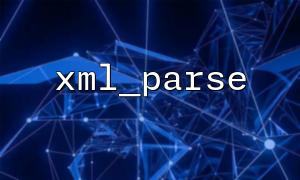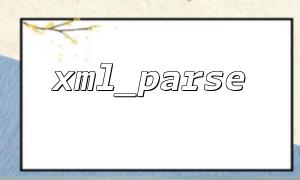In PHP, xml_parse is a commonly used function to parse XML data. It parses XML strings through a parser and converts them to PHP structures. However, when developers use the xml_parse function, they sometimes encounter a problem: entity characters (such as & ) in XML are not parsed correctly. This article will discuss the causes and solutions to this problem.
In XML documents, entities are alternative representations of certain characters. For example, & represents the & character, and < represents the < character. These entities help avoid conflicts with XML syntax, such as < and > for marking elements, while & is used to connect entities.
Generally, entity symbols come in two forms:
Predefined entities, such as & , < etc.
Custom entities that can be defined as specific symbols in XML documents.
However, in some cases, an entity may be escaped to form a string like & which means it is actually an entity of & ;
When processing XML data, the xml_parse function in PHP parses entity characters according to standard XML parsing rules. Under normal circumstances, xml_parse will convert & amp; to < to < , and correctly handle other entities based on the declaration and context of the XML document.
But the problem usually occurs when:
If entities in XML have been escaped (for example & ), the xml_parse function does not parse them further. This is because in XML , & is considered a normal string, not an entity that needs to be parsed. Simply put, & is actually an escape form of & , which will not automatically convert back to the original symbol &.
If custom entities are defined in XML, xml_parse may not be able to process them, especially if the document does not properly declare DTD (document type definition) or XML entities.
To address the above problems, you can take the following solutions:
If you encounter a situation like this, you can manually replace these double escaped entities before parsing . This can be achieved using str_replace . For example:
$xmlString = str_replace('&amp;', '&', $xmlString);
This code replaces & with & and then parses it. Note that this approach is suitable for situations where there are only specific entities.
If you find that the xml_parse function is not flexible enough, you can consider using simplexml_load_string to parse XML data. It is often able to handle entities better and provide a cleaner interface. For example:
$xmlString = str_replace('&amp;', '&', $xmlString);
$xml = simplexml_load_string($xmlString);
The simplexml function can usually handle common XML entities more intelligently.
If your application needs are more complex and involve custom entities or DTDs, you may want to consider using other XML parsing libraries, such as XMLReader , which provides more control and configuration options.
Here is a complete example showing how to process entities in XML and parse using the xml_parse function:
$xmlString = '<?xml version="1.0" encoding="UTF-8"?>
<root>
<example>&amp;</example>
<data>Some data</data>
</root>';
// Replace double escaped entities
$xmlString = str_replace('&amp;', '&', $xmlString);
// Create a parser
$parser = xml_parser_create();
// Analysis XML String
if (!xml_parse($parser, $xmlString, true)) {
echo "Error: " . xml_error_string(xml_get_error_code($parser));
} else {
echo "XML parsed successfully!";
}
// 释放Analysis器
xml_parser_free($parser);
In this example, we first replace the & entity in the XML string and parse it using xml_parse . If an error exists, the parser will return an error message.
Related Tags:
xml_parse














